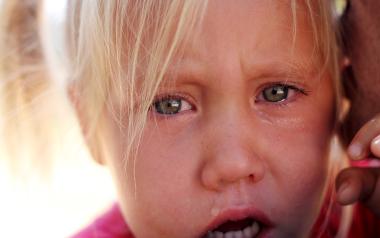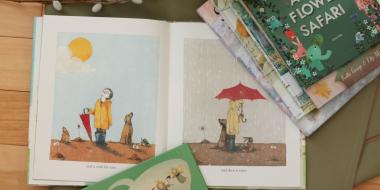Remember those times when, as a child, you felt so discouraged or misunderstood? And what about when you were a very small child before you could talk? You’d point, you’d make sounds, you’d jump up and down, and you still didn’t get what you wanted. Frustration set in and a tempest of yelling and crying commenced. “No one understands me!” you’d shout in your wordless voice.
THE VERY ANGRY TODDLER
Frustration and anger are normal emotions. They are not “good” or “bad”. It is only what our child decides to do with that emotion that can escalate into an issue and create problems—for instance, if a child chooses to hit or bite someone when they are angry. The solution is to better understand, from the child’s point of view, what role these emotions play and how a parent can help the child navigate them more effectively.
Anger can be a way for a child who is feeling ignored to get attention. It can also be the result of something taking place that they think is unfair, such as another child taking their toy, a sibling monopolizing a parent’s attention, or perhaps not getting something they wanted. Regardless of the reason, it is important that the anger be identified and acknowledged and that parents apply strategies that are effective for this age. Distraction can be a quick way to diffuse an issue like hitting, but this does not give our children the tools to help them calm their physiological reactions and develop and instill appropriate behavior in the long run.
It is hard for our preverbal children to express themselves. They not only don’t have the vocabulary to explain their feelings, they are only just learning about their own limits and boundaries. Both of these elements are necessary for a child to develop healthy coping skills. In the meantime, there are several things we, as parents, can do to help our very young children learn effective coping skills and how to express their emotions, such as frustration and anger, in a healthy way. First, we begin with our own reactions.
PAUSE, BREATHE, ASSESS
Dealing with a screaming toddler can be embarrassing, not to mention exhausting, especially in the middle of a grocery store. These moments can sometimes trigger a rush of anxiety and we may even react ourselves with anger.
Three immediate actions a parent must take are:
- Pause
- Take a deep breath
- Assess your own feelings
If you yourself are already cranky, tired, embarrassed, or hungry, you likely know you’re not in the best frame of mind to be effective. It is important to calm down, confidently take the lead, and model the behavior we want our children to mirror. If the parent reacts to the child’s anger by punishing, yelling, or shaming, this is what your child will learn to integrate into the experience of anger and how it will be coped with and dealt with. It is important to resist time-outs and withholding connection. Though difficult, it is okay to (briefly!) allow your child to continue expressing this emotion while you sit calmly nearby and take a few deep breaths to center yourself before addressing the issue.
When we get angry, our heart rate increases, our breathing becomes faster, and we release stress chemicals in our body. It is this physiological response that children, just like adults, need to learn how to calm and channel in socially acceptable ways.
TODDLER ANGER MANAGEMENT
There are several techniques that parents can teach children to help them through this process. Remember during this stage of development our children are testing limits and boundaries and becoming more independent. Tantrums and frustration are an understandable part of their experience before they acquire self-regulation skills. The goal is to help support the development of their independence while providing a safe environment and role modeling behavior they can eventually duplicate in working through their challenges.
Name that emotion
Once a parent stops and reflects on their own feelings, they are in a better frame of mind to take reasonable action with their children. Having tended to our own needs and remaining calm, help the child name the emotion they are having. There are some wonderful face expression tools such as “feelings posters” and “mood magnets” parents can use (buy them or make them yourself!) for the child to point to about how they are feeling. The parent can then use the emotion their child pointed to in a sentence.
“You are pointing to sad. When you are feeling this way, you say, ‘I am feeling sad.’”
This introduces the language they will learn to express themselves in a more mature way as they develop and learn self-regulation.
Teach mindfulness
This is the practice of simply paying attention to what the body feels when an emotion is being experienced. Helping your child do this can be as simple as bringing their attention to how their body is responding to the emotion.
For example, if you notice your child is breathing faster, you can acknowledge this by saying:
- “I notice you are breathing really fast.”
- “I see you have an angry face on.”
- “Your muscles are tight.”
As you are making these statements, role model visually and through tactile gestures what it looks and feels like to have the angry face and the tight muscles. Another great resource for this technique is the Sitting Still Like a Frog Activity Book (By Eline Snel; Bala Kids).
After stating your observations:
- Help them take deep breaths.
- Have them make the angriest face they can and then relax it.
- Show them how to tighten then relax their muscles.
This technique is very simple and effective for bringing awareness to their own behaviour.
Punch it out!
Some children may not be open to or ready for mindfulness activities in the beginning and need to run, yell, or hit something before they can calm themselves.
- Try making an obstacle course with soft objects in your back yard so your child can run around when they are angry.
- Designate a space in the house where your child can go to punch a pillow or punching bag or scream loudly.
Once your child has released the anger, sit with them and discuss what happened with the following elements:
- State your observations, what you may be feeling, and ask if your child is feeling better.
- Acknowledge the child for processing their anger in a safe and appropriate way. Give specific examples of what behaviors your child carried out that you appreciated.
- Honour them for the unique being they are and are becoming. It is important after expressing themselves in this way to know they are still loved.
Act, play, or draw it out
If you have a child who is not a screamer and gets really quiet, use that same space in your house be a “reflection” corner with a “calm down” kit of special toys and art supplies for them to play out or to draw their emotions. You could even draw with your child a picture of how you are feeling in the moment, too! Afterwards, you both can share your art pieces with one another and talk about it.
Even if your child cannot respond in full sentences, you can talk with them about things such as:
- “I see you used a lot of red here.”
- “Those strokes look really angry.”
- “These colors make me feel sad. Are you feeling sad?”
- “I drew this because I was feeling hurt.”
This is a great opportunity to incorporate “Name that emotion”!
Helping to provide our very young children with tools to work through frustration and anger, rather than avoid them or punish them for it, will provide them with a resource and building blocks they will use the rest of their lives. The next time your child throws a fit, take a long, deep breath and help them learn to do the same.






